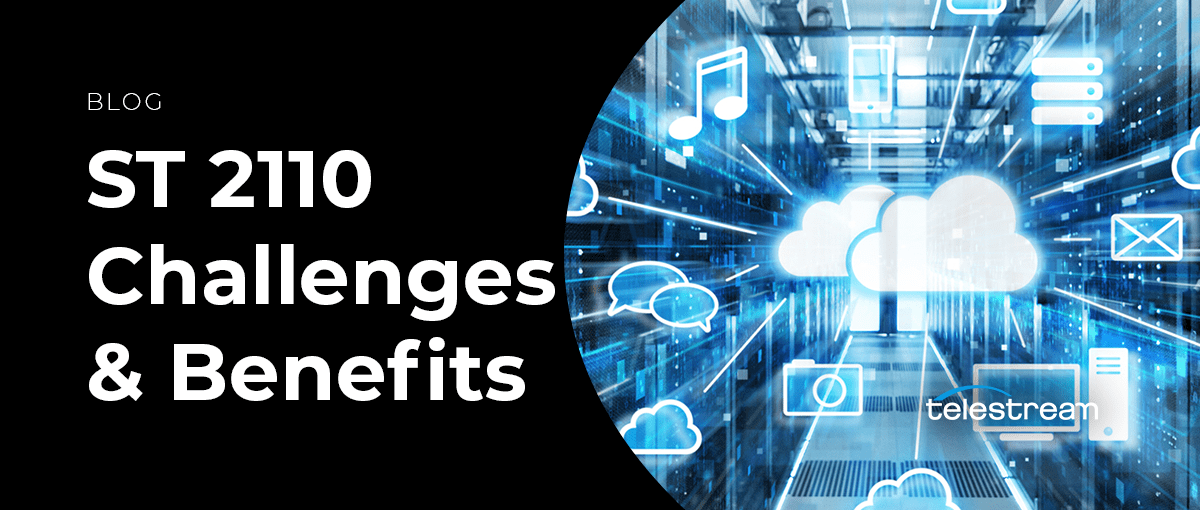The broadcast industry has gone through several evolutions over the years. There was the transition from analog to digital, from standard definition to high definition, to 4K and onwards to 8K. Broadcast facilities are also transitioning from SDI to IP to tap into benefits of additional scalability and flexibility. While the underlying technology for transporting media will change, operational staff can facilitate a seamless transition and still perform their jobs in the same manner with similar or identical workflows. Here are the requirements, challenges, and benefits to adopting ST 2110 standards for facilities transitioning from SDI to IP. Stay tuned for future blogs that will further explore ST 2110 broadcast production workflows.
Broadcast Media Teams Need To Meet Two Fundamental Requirements
Whether for traditional distribution or OTT, modern broadcast production teams need to satisfy two critical needs:
- The need for high-end distribution of higher-resolution content to larger-format displays.
- The need for widespread content distribution, from mobile phones, to tablets, to a variety of large-screen displays. These require different resolutions, as well as different transport methods (like over-the-air, cable, and streaming).
These two requirements may seem to oppose each other. Starting with high-quality, high-resolution content provides flexibility to produce various formats and meet the needs of diverse viewing platforms.
The Switch from SDI to IP and ST 2110
Broadcast media operations teams are looking toward newer, more efficient technologies to streamline workflows from content capture to production, optimization, and distribution. One critical enabler is the advent of ST 2110 standards for IP-based media workflows. These new protocols have changed the way content is produced, delivered, and monetized. They are also introducing new challenges and opportunities for production teams.
Adapting to these new standards may seem complex and intimidating, especially to teams who are accustomed to traditional SDI-based environments. However, there are numerous benefits to incorporating these IP-based production workflows, even if only partially. Engineers that are building and maintaining large-scale production operations will benefit significantly from ST 2110 automation and collaboration capabilities.
PTP: The Cornerstone of Any Robust ST 2110 Network
A successful ST 2110-based production relies on a network of systems and tools that can seamlessly communicate and interoperate together. A cornerstone to this IP media network is Precision Time Protocol, or PTP. PTP allows for synchronization of media nodes across the network.
In hybrid systems there is a need to maintain traditional analog and digital references alongside PTP. This supports a variety of different infrastructures within the facility. Therefore, the master sync pulse generator needs to be able to support traditional synchronization needs while providing PTP time sources across the IP media network.
Integrated Hardware/Software Solutions for Monitoring ST 2110 Production Networks
Flexible, scalable, and intuitive solutions for synchronization, timing, and reference test signal generation can provide primary and backup master clock references for ST2022-7 fault tolerant and redundant network operations. These should be locked to a GNSS (Global Navigation Satellite System) reference to provide global referencing around the world. To ensure continuous operation of your facility, monitoring solutions such as IP network monitoring devices and hybrid SDI/IP waveform monitors create a cohesive, tightly-integrated production. This solution ensures that content is of the utmost quality for all displays: from the largest formats to the smallest screens.
A successful ST 2110-based production relies upon a network of systems and tools that seamlessly communicate and interoperate with each other. A network monitoring solution that monitors by exception will look for specific problems and alert the operator with simple alarms and warnings across video, audio, and data streams. These alarms can be used by operators and engineers to help quickly isolate any issue and provide fault diagnosis quickly. By integrating this tool with a production’s waveform monitoring devices, broadcast operations teams can further investigate any issues inside of these streams. These tools can be deployed locally, or remotely through a secure web browser via WebRTC. This facilitates more tight-knit collaboration between operational and engineering staff, no matter where they may be located. Using this WebRTC connectivity, users can view the streams in near real-time and help diagnose issues.
The Technical Case for ST 2110 and IP Production Workflows
Modern production tools that make best use of IP-based production workflows via ST 2110 can enable high-quality, efficient, scalable media production and distribution. These tools enable collaboration among remote and dispersed workforces, synchronize media and feeds across various sources, and monitor content and networks to ensure optimal delivery. Adopting these solutions can deliver significant benefits for broadcast production, post production, and operations teams. Those intimidated by the prospect of migrating to hybrid or IP-based workflows should look to Telestream’s 2110-supported production solutions. These include the SPG9000, Inspect 2110, and PRISM, which can make the transition easy and seamless.

